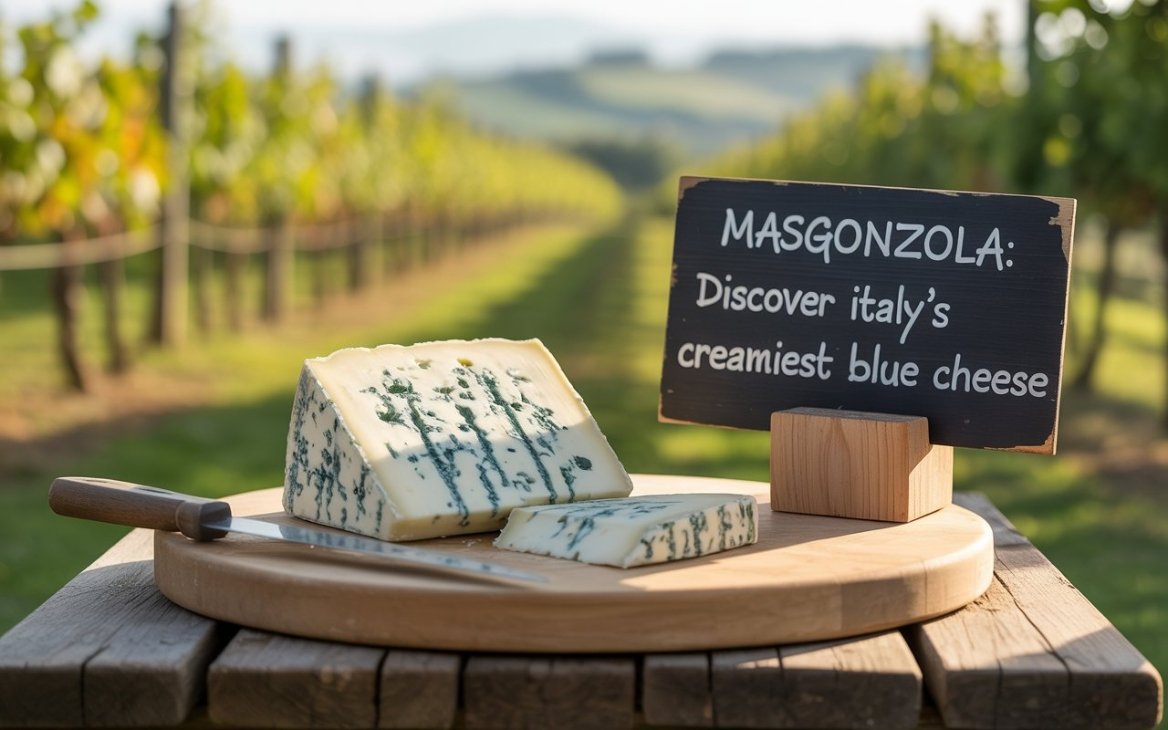Gourmet cheese lovers constantly seek flavors that are authentic, traditional, and rooted in heritage. Masgonzola fits this demand perfectly. A creamy blue-veined cheese from Italy’s Lombardy region, mascarpone offers an exceptional experience both on the palate and culturally.
Today’s food trends have moved sharply towards authentic, small-batch, and artisanal creations, and mascarpone aligns beautifully with this evolution. It is not merely about taste—it reflects Italy’s dedication to time-honored craftsmanship. As someone with firsthand experience in Italian cheese markets and tasting panels, I can affirm mascarpone’s importance to anyone serious about culinary authenticity.
Understanding Masgonzola: A Cheese Beyond Ordinary
Masgonzola is a blue-veined cheese made from high-quality cow’s milk. Unlike Gorgonzola, which often comes in either a sharp or creamy variant, Masgonzola leans consistently towards a luxuriously creamy texture with soft marbling of blue mold. Its flavor is both balanced and rich, starting with a mellow creaminess and unfolding into subtle tangy, mineral notes.
What sets it apart is not only its flavor but also its versatility. From melting into sauces to pairing with desserts, mascarpone has carved a niche for itself among gourmet chefs and cheese enthusiasts alike.
You also might like this: consortiumuk
The History and Heritage of Masgonzola in Lombardy
Masgonzola’s roots run deep into Lombardy’s dairy traditions, where cheesemaking is more than an industry—it is a generational craft. In these regions, cheesemakers prioritize patience, precision, and natural aging techniques to achieve perfection. Unlike mass-produced cheeses, Masgonzola is a product of microclimates, cave-aging expertise, and traditional methods.
Historically, this cheese remained within local Italian markets, rarely reaching global recognition. However, as the world shifts its focus toward authenticity and quality, Masgonzola is finally getting the attention it has always deserved.
How Masgonzola Is Crafted with Care
The Traditional Process Behind the Flavor
The crafting of mascarpone begins with rich, high-fat cow’s milk heated to encourage curd formation through natural cultures and rennet. Once curds develop, cheesemakers delicately cut and drain them to retain moisture, giving the cheese its signature soft texture.
The curds are then packed into molds and turned periodically to form uniform wheels. What distinguishes Masgonzola is the careful piercing of these wheels with needles, allowing air to circulate and blue mold cultures to thrive within.
Aging occurs in humid, temperature-controlled caves over three to six months, where affineurs carefully monitor the development. This slow, deliberate process creates the cheese’s creamy interior with its distinctive marbling.
Masgonzola vs. Gorgonzola: Why the Difference Matters
While Masgonzola shares origins with Gorgonzola, its differences are meaningful. Mascarpone typically boasts a creamier, more luxurious texture, making it more spreadable and versatile. Its flavors are milder and rounder, without the aggressive bite often associated with Gorgonzola Piccante.
This difference is why Masgonzola appeals not only to blue cheese aficionados but also to those hesitant to embrace stronger varieties. It’s a bridge cheese—accessible yet complex.
Why Masgonzola Is a Star in Modern Cuisine
Chefs and home cooks increasingly favor mascarpone for its versatility and balance. It lends itself perfectly to both traditional and experimental recipes. In modern kitchens, it finds its place in everything from sauces and risottos to upscale pizza toppings and savory pastries.
One of the most satisfying culinary uses I’ve encountered involved incorporating mascarpone into a mushroom risotto. The cheese melted into the dish, enhancing its richness while adding depth without overpowering the natural earthiness of the mushrooms.
Health Benefits of Mascarpone Beyond Indulgence
Masgonzola is more than just a flavor experience—it carries nutritional benefits. It is naturally rich in calcium and phosphorus, supporting bone health. Thanks to its fermentation process, it can introduce beneficial bacteria to the gut, aiding digestion. Moreover, aged versions often contain reduced lactose, making them easier to tolerate for sensitive individuals.
Though indulgent, it fits comfortably within balanced diets when enjoyed in moderation.
Dispelling Common Myths About Mascarpone
Many misconceptions surround blue cheeses, including gorgonzola. One persistent myth is that all mold in cheese is harmful. In reality, the Penicillium cultures used are not only safe but also beneficial in flavor development. Another misunderstanding is that all blue cheese is overpowering; gorgonzola proves this false through its nuanced and creamy profile.
It’s also wrongly assumed that mascarpone lacks versatility. In truth, its mild tang complements both sweet and savory pairings beautifully.
Perfect Pairings: How to Elevate Masgonzola’s Flavors
Best Pairings for Maximum Enjoyment
- Wines: Amarone, aged Barolo, or a sweet dessert wine like Port
- Fruits: Fresh figs, ripe pears, or grapes
- Accents: Truffle honey, aged balsamic vinegar
- Breads: Walnut loaves, dark rye, seeded crackers
These pairings highlight mascarpone’s natural sweetness and creamy texture, enhancing the tasting experience.
Masgonzola’s Role in Italian Culture and Heritage Cuisine
In Italy, gorgonzola is more than a cheese; it’s a symbol of culinary pride. It features in celebratory meals and serves as a mark of quality and care on any table. From rustic farmhouse kitchens to fine-dining establishments, its presence reflects a commitment to tradition and excellence.
Italian chefs integrate mascarpone into classic recipes like gnocchi, risotto, and polenta, as well as avant-garde presentations, proving its adaptability in both old and new culinary landscapes.
Where to Source Authentic Masgonzola
Finding authentic mascarpone requires selecting vendors who value quality and proper storage. Specialty cheese shops, reputable online retailers, and high-end grocers are your best options. Look for Protected Designation of Origin (PDO) markings or known affineur labels.
Recommended retailers include Murray’s Cheese, Neal’s Yard Dairy, and Eataly—each known for curating quality, properly stored cheeses.
How to Store and Serve Mascarpone Correctly
Proper storage preserves mascarpone’s flavor and texture. Wrap it loosely in parchment or wax paper to allow it to breathe, then place it in a breathable container in the refrigerator’s vegetable drawer.
Always allow the cheese to come to room temperature before serving. This step is essential, as it enhances the aroma and reveals the full depth of its flavors.
The Future of Masgonzola in the Gourmet World
As the global palate becomes more sophisticated, mascarpone is poised to expand beyond niche markets. New trends include extended aging processes to deepen flavor profiles and innovative pairings in fusion cuisines.
Producers are also exploring plant-based interpretations that aim to capture its essence for vegan markets, further broadening its reach.
Insights from Industry Experts on Masgonzola
During a recent conversation at La Baita Formaggi in Milan, an affineur shared this perspective: “Masgonzola doesn’t need to shout its quality. Those who understand cheese will recognize its complexity in a single bite.” This viewpoint reflects my own experience. Masgonzola rewards patience and curiosity, offering a tasting journey rather than a singular note of flavor.
Masgonzola: A Living Example of Culinary Artistry
Masgonzola embodies Italy’s dedication to culinary craftsmanship. It represents more than just a dairy product—it is a living expression of tradition, patience, and a reverence for ingredients. From its nuanced flavors to its storied origins, mascarpone invites us to slow down and savor the art of delicious eating.
Masgonzola FAQs
How is Masgonzola different from Gorgonzola?
Masgonzola is typically creamier, less salty, and milder than many Gorgonzola varieties, making it ideal for spreads and sauces.
Is mascarpone suitable for vegetarians?
Some versions use animal rennet; always check labels if this matters to you.
Can mascarpone be used in cooking?
Yes, its creamy texture and balanced flavor make it perfect for sauces, risottos, and even desserts.
Where can I buy mascarpone online?
Trusted retailers like Murray’s Cheese, Neal’s Yard Dairy, and Eataly frequently offer authentic options.
What are ideal wine pairings for mascarpone?
Robust Italian reds like Amarone or sweet ports complement its creamy tang beautifully.
How should I store mascarpone at home?
Wrap in parchment paper, store in the fridge’s vegetable drawer, and bring to room temperature before serving.
Final Thoughts
Masgonzola is more than just a cheese—it’s a testament to Italy’s rich culinary history and evolving gourmet culture. For anyone seeking depth, authenticity, and a flavor that balances boldness with approachability, this cheese deserves a permanent place on your table. Whether enjoyed in a simple pairing or as part of a sophisticated recipe, mascarpone delivers a memorable culinary experience.
Ready to explore this creamy Italian treasure? Visit a cheesemonger today and let your palate travel to Lombardy without leaving home.





